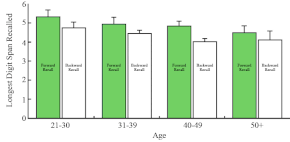Memory span
| Memory span | |
|---|---|
| Medical diagnostics | |

This is a graphical representation of typical results that might be obtained from performing a forward/backward digit span recall task on participants in several different age groups. The numbers on the y-axis indicate number of digits successfully recalled.
|
|
| MeSH | D011581 |
In psychology and neuroscience, memory span is the longest list of items that a person can repeat back in correct order immediately after presentation on 50% of all trials. Items may include words, numbers, or letters. The task is known as digit span when numbers are used. Memory span is a common measure of short-term memory. It is also a component of cognitive ability tests such as the WAIS. Backward memory span is a more challenging variation which involves recalling items in reverse order.
Functionally, memory span is to measure the number of discrete units over which the individual can successively distribute his attention and still organize them into a working unit. To generalize, it refers to the ability of an individual to reproduce immediately, after one presentation, a series of discrete stimuli in their original order.
Experiments in memory span have found that the more familiar a person is with the type of subject matter presented to them, the more they will remember it in a novel setting. For example, a person will better remember a sequence in their first-language than their second-language; a person will also remember a sequence of words better than they would a sequence of nonsense syllables.
According to a theory by Alan Baddeley and Graham Hitch, working memory is under the influence of three key mechanisms: the visuospatial sketchpad, the central executive, and the phonological loop. A mechanism called the episodic buffer was later added to the model. The phonological loop is the mechanism that facilitates learning and memory by storing information (in the articulatory loop) and refreshing or rehearsing it in our memory (in the acoustic store). The phonological similarity effect is when items in a list have similar features (e.g. similar sound), they are more difficult to remember. Likewise, the more different the items in a list are, the easier it is to recall them. Memory span tasks since the formulation lof Baddeley and Hitch's theory have been helpful as support for the phonological loop as part of the working memory.
A structural definition of memory span is difficult to give, for one immediately is faced by the distinctions between the prerequisites for memory span, and the actual processes involved. "Associability” is required in memory span. This term refers to the ability of the subject to group the series of elements together: to perceive relationships among the series in order to better reproduce them. Still another process involved in memory span is that of imagery. The subject, in order to be able to reproduce the series presented, must be able to image the series. The actual reproducing of the series of stimuli involves the process of memory. If the individual possessed no memory at all, reproduction of the series would be impossible. It is also known that memory span and memory are different in the length of time over which reproduction is possible. Memory span is transitory; memory is fairly permanent. In addition, the amount of material involved in memory span is ordinarily much less than the amount of material involved in memory. Reproduction of the series also involves certain other "reproduction factors," such as language ability and arithmetical proficiency.
...
Wikipedia
